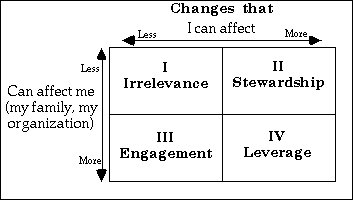
The Four Quadrants of Change
International Copyright 1996 Joe Flower All Rights Reserved
Please see our free downloading policy.
What's the best response to change? That depends on your relationship to the change -- to a great extent, on the power balance. How much power does this change have to affect you or your organization or family? How much power do you have to control it or shift its direction? The answer to those two questions will give us one lens through which we can look at change.
Picture a simple diagram:

We are not vulnerable to changes in the first two quadrants. They have little power to effect us. How we respond to them depends on how much power we have over them.
Quadrant I -- Irrelevance: Here we find matters which don't have any true effect on us, and over which we have little power. I have plenty of opinions about the Bosnia situation, private militias, and the proper raising of twins, but unless I make one of these things my business (by joining an advocacy group or adopting twins), my opinions don't mean much. Yet, like many people, I can spend a surprising amount of energy on matters that belong in Quadrant I.
The goal for Quadrant I is simply to recognize the matters that properly belongs here as the energy sinks that they are -- and to scan for matters that could become newly relevant, such as a technological change that may hit the market next year, or pending healthcare reform legislation.
Quadrant II -- Stewardship: We have more power over these changes than they have over us. Changes that deal with children, subordinates and employees, for instance, often fall in this category. Too often, it feels like we can safely give changes in these unequal relationships only minimal attention. But here, unlike in Quadrant I, we do have a relationship, and everything with which we have a relationship has a reciprocal power over us. The power of unequal relationships can be deceptive -- and the more unequal they are, the more deceptive they can be. When they suddenly reveal that we have less power over them than we thought, as in a strike or an adolescent rebellion, it is easy to respond with moral outrage, as if the foundations of all that is good and right had been overturned.
The goal for Quadrant II is two-fold: to honor our responsibility, and to give away some power. A subordinate who has no options and can make no choices is dangerously disconnected from the relationship, and can only express themselves through subversion and rebellion.
Quadrant III -- Engagement: Some changes have enormous power over us, and we can't do much to effect them -- a hurricane, new tax laws, a shift in reimbursement rules, changes in the population mix of your service area.
Here again we have twin goals. The first: don't get hurt. Train's coming, get off the track. Make the organizational changes you need to minimize your exposure, and make them rapidly, before you feel the full effects, not after.
The second goal: discover what's in it for you. When you're on the track, the train is a deadly danger. Step a little to one side, it's a passing freight, and maybe you'd like a free ride across town.
If I want to take that free ride, though, I have to stay close to the train. Simply running from difficult changes is rarely effective.
Quadrant IV -- Leverage: Finally, there are the changes which can affect us -- and which we can affect equally. This quadrant represents the "key change area," where we are most vulnerable, yet we also stand to gain the most.
Again, the first goal is: get out of the way. The second: search for the point of maximum leverage, where you can shift the momentum of the change in a direction that you would like it to go.
How change works | Change happens | The five fundamentals of change| What is your goal? | Core concepts | Skills| Skill-building resources | Touching what is, touching what might be | Paradox | Heading for the open space | Habits of mind | Psychological roots | Change Processes | Main Page